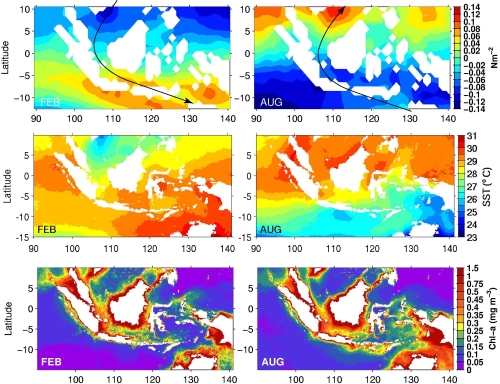CHLOROPHYLL-a VARIABILITY IN THE INDONESIAN SEAS
Because of its longitudinal extent (90° to 141°E), the Indonesian Seas contain a significant part of the tropical ocean productivity. The majority of the ocean’s productivity occurs within the tropics along the equatorial band of 10°N to 10°S (Longhurst, 1993). Indonesia is also a center of biological diversity (Veron, 1995), and one of the region in the world that exhibits high variability in ocean color (Yoder and Kennelly, 2003), and the site of important fisheries, such as off the Halmahera coast (western Pacific warm pool region; Lehodey et al, 1997) and the upwelling region in the eastern tropical Indian Ocean along the southern coasts of Java and Sumatra. The 1997/1998 ENSO was detected through observation of satellite-derived ocean color (expressed as chlorophyll-a) in the Indonesian seas. In summary, the strong 1997/1998 El Niño followed by a La Niña period, coinciding with an Indian Ocean Dipole event, is associated with higher chlorophyll-a values in the upwelling region along the southern coasts of Java and Sumatra. Higher chlorophyll-a values are observed during the southeast monsoon cycle (April-October) than those of northwest monsoon.

Figure 1. Monthly mean wind stress (top) sea surface temperature (middle) and chlorophyll-a (bottom) for the months of Febraury and August to represent northwest and southeast monsoon respectively. (Susanto and Marra, 2005; Susanto et al., 2006).